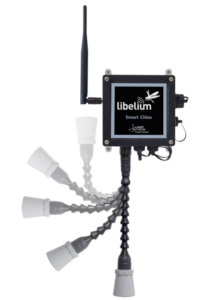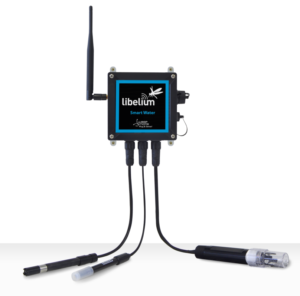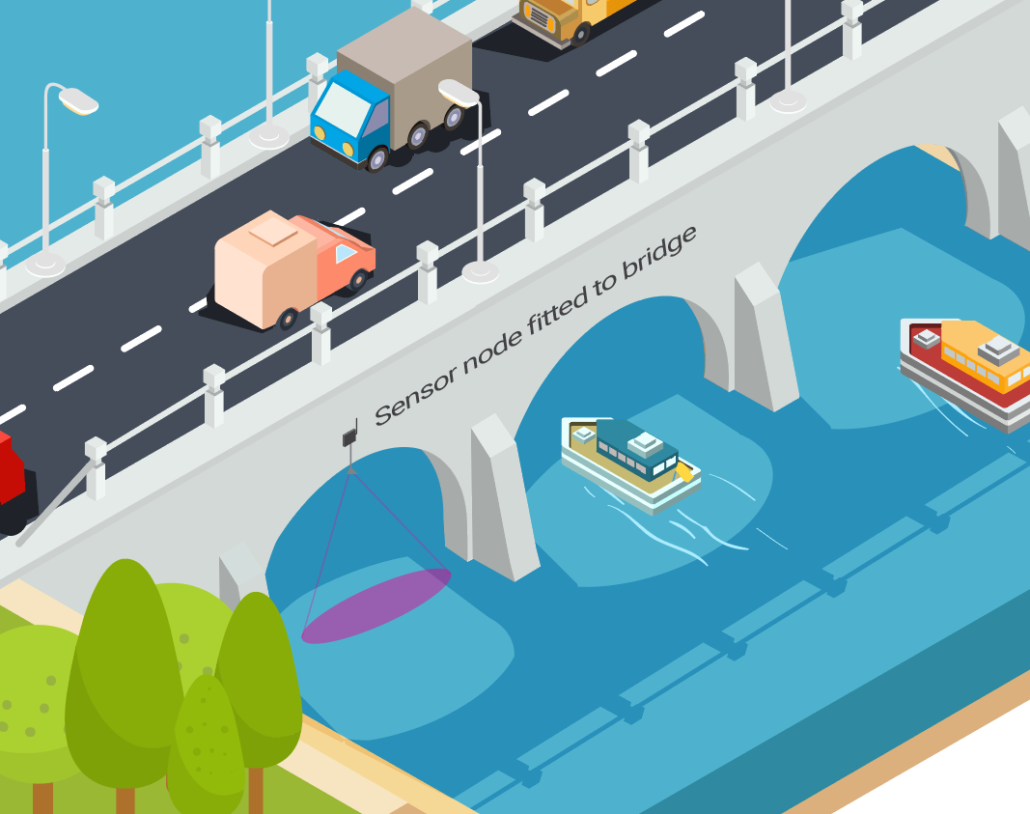
The ability to remotely monitor river and stream levels is crucial for effective water management and reducing the impact of flooding and environmental hazards. Thanks to the Internet of Things (IoT) technology, continuous monitoring of river or creek levels in multiple locations has become more accessible and efficient.
With real-time data transmitted wirelessly, stakeholders can make informed decisions to safeguard communities, infrastructure, and the environment. This blog post delves into the components and sensors required to monitor river or creek levels, focusing on ultrasonic sensors.

The three most common sensors used to measure river levels with IoT are ultrasonic, radar and depth sensors. In this post, we are going to focus on the use of ultrasonic sensors.
To provide a simple explanation, we have broken the solution into Sensors, Network and Cloud.
- Sensors.
- Libelium Plug&Sense (Smart Water Xtreme or Smart Cities), with the Ultrasonic Sensor (Maxbotix MB7040). A radar sensor can be used in place of the ultrasonic sensor, with the added benefit of increased accuracy and range.
- Milesight EM500-UDL sensors incorporate a Maxbotix sensor, 19,000mAh battery and LoRaWAN. The IP67 sensor can be rapidly deployed and are suitable for harsh environments.
- Network. The Libelium Plug&Sense supports LoRaWAN and cellular 3G/4G. For remote locations, there is also the option of using a LoRaWAN-Satellite gateway.
- Cloud. A range of cloud platforms is supported. The most common platforms we work with include Microsoft Azure, AWS, custom web applications and conventional database systems.
Sensors
For this scenario, we will be using ultrasonic distance sensors. You may also want to include temperature, humidity and pressure, a weather station, and a water-flow meter for river applications.
An ultrasonic sensor emits sound toward an object and detects the sound reflecting to determine distance. The sensor then measures the time between each point to determine the distance between the sensor and the measured object. The sound emitted by the sensor is at a high frequency, inaudible to the human ear, but it allows for a focused ‘beam’ (42KHz).
A typical ultrasonic sensor can measure the distance from 30cm to 10m – with an accuracy of 1cm throughout this range. Sampling intervals can be as little as one minute, but ten minutes is more common.
How do I power the sensor?
The Libelium Plug&Sense includes a built-in 6000mA-H battery and support for an external solar panel. Using batteries and renewables allows the sensor nodes to be deployed in remote environments.
Milesight UDL-5000 is entirely battery-powered, with no requirement for solar panels or external power.
Network

Wireless technologies such as LoRaWAN and 3G/4G are supported by the Libelium Plug & Sense. The flexible range of options allows you to choose the right wireless technology to send data back to your systems or application servers. For very remote locations, a technology such as LoRaWAN (supported by the node) and a LoRaWAN-Satellite gateway allow water monitoring from anywhere in the world.
Cloud
Data from the sensors (once transmitted) needs to be processed and stored. The use of cloud platforms such as Microsoft Azure is perfect for IoT. However, the platform supports sending data to Azure, AWS and familiar application/database servers.
If you prefer an easy-to-use, customisable solution – we also support Datacake and Milesight Cloud.
Once in the cloud, you can develop additional functionality such as alerting and notifications (i.e. if the river level exceeds a given level or there is an upwards/downwards trend of significance).
Remote water level monitoring solution
The sensor node is strategically affixed to a river structure, such as a bridge, or mounted on a pole positioned near the river that requires monitoring. Connected to this node, the ultrasonic sensor is installed at a specific height above the body of water, where it continuously measures the distance between itself and the water surface.
Any fluctuations in the sensor’s readings can be accurately interpreted by establishing a reference point for the river’s depth at the monitoring location. For example, a decrease in the sensor value (e.g., 25 cm) would signify a drop in water levels, whereas an increase (e.g., +15 cm) would imply a rise in water levels.
Positioning
To ensure accurate data, selecting an appropriate mounting location for the sensor node that minimizes potential interference from debris or obstructions is essential. Additionally, regular maintenance and calibration of the ultrasonic sensor are crucial to guarantee the reliability of the measurements.
Considerations
When setting up a river level monitoring system, it’s essential to consider factors such as the river’s flow rate, seasonal variations, and the potential for sudden changes due to weather events. These considerations can help stakeholders set appropriate alert thresholds for proactive flood management and water resource planning.

Sampling Intervals
The sensor node will transmit this measurement back to the cloud platform. Measurement intervals can be as few seconds, but a practical range would be every 15 minutes. For higher-risk rivers or where pre-emptive flood detection is needed – you may want to measure levels every minute.
The only disadvantage of more aggressive sampling intervals is the battery life of the sensor node. More measurements mean more power consumption – an important consideration if the battery and solar panels power the sensor node.
Alert and notifications
Once the data is in a cloud platform, applications can be developed that do the following:
- Visualise the water-level data on a dashboard.
- Send text messages when water levels exceed a given value.
- Generate alerts (text or e-mail) when the water levels increase at a given gradient.
- Send messages via Slack, Microsoft Teams or WhatsApp when thresholds are exceeded.
- Combine reports with weather data to understand the correlation and risk factors associated with water levels and weather.
Using data for effective water management
The data acquired from the IoT-based river level monitoring system can be analyzed and visualized through custom software or web platforms, providing stakeholders with easily accessible and digestible information.
This real-time data enables decision-makers to respond promptly to changing water levels, such as adjusting water flow at dams or issuing flood warnings to affected communities.
Moreover, the historical data collected over time can be employed for trend analysis, long-term water resource management, and infrastructure planning to mitigate potential risks and improve overall water management strategies.
Early warning flood monitoring
It is easy to see how remote water level monitoring can also be used in flood monitoring and flood protection scenarios:
- Sensors can be deployed throughout the Long Profile of a river or river network (i.e. lower, middle and upper courses).
- IoT sensors can monitor levels of rivers, lakes and streams throughout the network.
- River sensors can be combined with weather stations to monitor rainfall.
- The rate at which river levels increase throughout the network can be monitored in real-time.
Flow-rate monitoring
Monitoring river velocity and flow using radar planar microwave technology with doppler radar technology is possible.
River flow/streamflow monitoring
When level sensors are combined with flow sensors, it is possible to calculate the volume of water flowing down a river. Monitoring river flow is covered in the following article.
Digital Twins – Rivers
Digital Twins can use the data arising from sensors to create detailed models of river systems. IoT technology can be the foundation of a Digital Twin solution when coupled with data analysis, machine learning, artificial intelligence (AI) and visualisation tools.
Digital Twins can incorporate additional sensors into their modelling:
- Soil moisture sensors at different depths allow you to monitor the status of the water table.
- Weather stations allow accurate data analysis such as rainfall, pressure, temperature, wind and solar radiation.
- External data sources such as topographic and terrain data.
Data visualisation and reporting
The data collected from IoT sensors can be used for detailed data analysis and reporting. Depending on the choice of platform, data can be brought into common database platforms such as Microsoft SQL Server or MySQL.
The data can be visualised using Power BI, Tableau and Zoho Analytics tools. For simpler use-cases, data can be downloaded in CSV or Excel format.
Sensor summary
- River level sensor – Ultrasonic, radar and pressure sensors.
- Weather stations – Rainfall, wind, solar radiation, pressure and temperature.
- Turbidity, ORP, Dissolved Oxygen
- Soil moisture sensors – available at different depths
- River flow and velocity sensors – Radar/Doppler sensors
What else can I monitor?
In addition to water levels, we can monitor a wide range of parameters associated with water, such as pH, ORP, Dissolved Oxygen, BOD/COD and conductivity. To learn more, review the following blog posts:
- Smart Water with IoT
- River flow and streamflow monitoring with IoT
- Monitoring Turbidity with IoT
- Monitoring water quality with IoT and Microsoft Azure
Conclusion
IoT technology has revolutionized the way we monitor river levels by providing remote, high-precision monitoring solutions that are both reliable and cost-effective. Ultrasonic sensors, combined with advanced systems such as Milesight and the Libelium Plug&Sense, offer field-tested and dependable solutions compatible with various communication technologies.
To protect our communities, infrastructure, and environment from the impacts of fluctuating water levels, stakeholders need to invest in and embrace IoT-based monitoring systems. By doing so, they can ensure access to real-time data, facilitate proactive decision-making, and ultimately promote more sustainable water management practices.
Don’t wait for the next flood or water crisis to strike; take action today by implementing IoT solutions that can significantly improve river-level monitoring and contribute to a more resilient future.
More information
If you would like to learn more about our products and services, request pricing, or discuss a project requirement - you can MTG using the details below. Alternatively, you can e-mail sales@mtg.im for more information.

